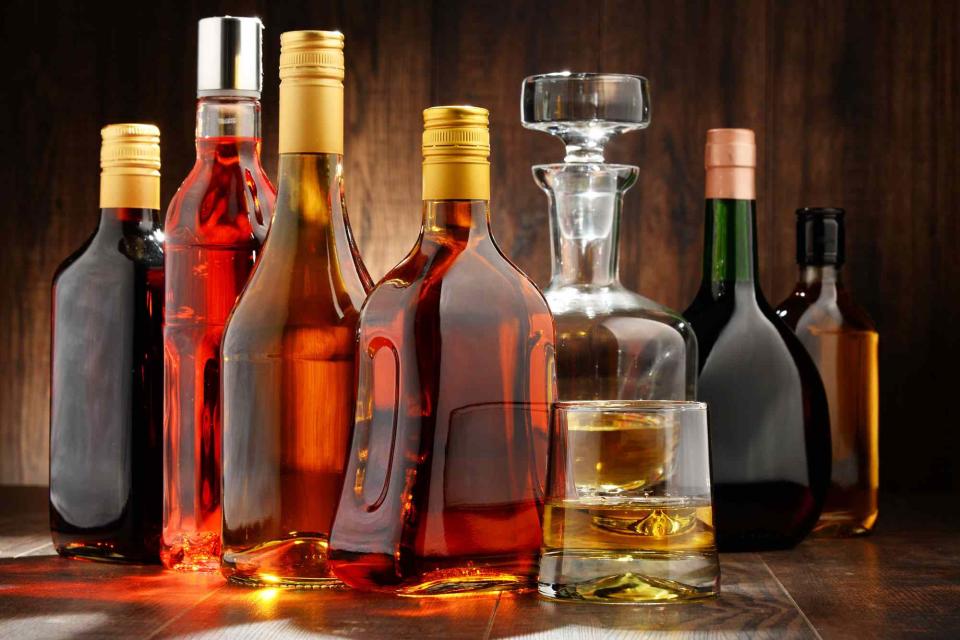What’s the Difference Between a Liqueur and a Spirit?
Think of spirits as your canvas, and liqueurs are highly collectible, colorful paints.

Monticelllo / GETTY IMAGES
There are only two sorts of visits to your neighborhood liquor store. There’s the efficient, somewhat hurried stop before a last-minute dinner party, that housewarming you completely forgot about, or while you’re on your way to comfort a friend who’s had a particularly grueling day at work. Then, there’s the leisurely stroll through bottle shop shelves filled with charming, familiar labels and grape names. On these visits, you’re more likely to notice and take a closer look at the occasional bottle that you’ve never seen before (and might not be sure how to pronounce), but desperately wish to display on your home bar.
In the latter case, understanding whether that new-to-you bottle falls into the category of a spirit or a liqueur can be the key to swapping it into classic cocktail recipes, or devising entirely new ones; it can also help you decide whether you should try sipping it neat, or on the rocks. There are several key characteristics that set the two groupings apart, and it’s important to bear in mind that “liquor” and “liqueur” aren’t just different spellings or pronunciations of the same term; in fact, liquor is a broader category to which liqueurs and spirits belong.
What Is a Spirit?
Simply put, you can’t make a liqueur without a spirit. A spirit is created by distilling fruit, grain, sugarcane or various other ingredients with naturally present sugars. “A spirit starts with fermentation of the base product, which in essence, creates a wine or beer that is then run through a still. The resulting product from the still is a spirit,” explains Neal Bodenheimer, owner of Cure and Cane & Table in New Orleans.
For Jack McGarry, managing partner of iconic New York City cocktail bar The Dead Rabbit, spirits have always been the base constituting the majority of the drink, and therefore their true foundational component. “Liqueurs are modifiers, adding context and nuance to a mixed drink. I've always thought of spirits as a textured, nuanced canvas, with liqueurs accentuating and contributing to said canvas,” he says. Anyone who’s enjoyed an Aviation cocktail knows that without maraschino liqueur and creme de violette, all you’re really sipping is gin; Chartreuse is what steers a Champs Elysees from being mistaken for a Sidecar.
Once you start looking at classic cocktails as having spirits for their base canvas and liqeurs as their colorful, exciting modifiers, you’ll start to see how different drinks are connected to one another. For example, a Negroni without Campari liqueur is just gin and vermouth, making for an entirely different (though still delicious drink) — a Martini. It’s this connection that will enable you to get creative and confident with bringing new bottles into your repertoire.
What Is a Liqueur?
When I was younger, I remember seeing colorful bottles of alcohol with pictures of strawberries, bananas, and sour cherries inside of my grandparents’ vitrine. They were trotted out for special occasions, and while they looked (and often smelled) like hard candy, I knew I wasn’t to touch them, at least, not yet.
As I got older, I learned that those candy-scented bottles contained cordials, which is another term for liqueur. According to Lynette Marrero, co-founder of women’s bartending competition SpeedRack, liqueurs are simply distilled spirits that are sweetened and flavored. “They often have fruits, nuts, herbs, and spices, even coffee or chocolate added to them,” she explains. Liqueurs are typically lower in alcohol than a base spirit on its own, making them easier to sip than, say, a shot of tequila or whiskey, but that’s not to say you should assume this entire category is light and sessionable. “There are some higher proof liqueurs like Chartreuse, Cointreau, and Grand Marnier that pack a base spirit punch,” Marerro adds.
As it often tends to be the case when artificial flavoring is involved, not all liqueurs are created equal. “The base distillate, flavor, sweetness level and sweetener used are some of the main contributing factors to the quality of the final product,” explains Bodenheimer. If you’ve ever had a perfect Espresso Martini, you know the difference a well-made coffee liqueur can make. Some, like Mr. Black, are rum-based with minimal sweetness, while others, like Kahlúa, are vodka-based and sweeter.
How to Choose a Liqueur
As someone who loves to get creative with cocktails but lives in a small Brooklyn apartment, I know that every fun new bottle takes up precious space on my bar cart. It can be tempting to over-index on the spirit front while skimping on liqueurs, many of which (like créme de menthe and maraschino liqueur) might have relatively limited use cases. You’ll find it challenging to pull off a classic Margarita or Sidecar without a bottle of Cointreau or Grand Marnier, both of which are liqueurs. If you’re working with truly limited space, try picking liqueurs that play especially well with one or two of your favorite spirit canvases. For example, if you’re a rum fan, you can get serious mileage out of a passion fruit liqueur like Chinola. Love tequila? Luxardo might be your new best friend.
The world of liqueurs is incredibly vast, and the more of these wonderful bottles you add to your collection — like Ojen, the licorice flavored Mardi Gras liqueur that makes for a wonderful addition to a classic French 75, or pastis-esque D’Aristi Xtabentún from Yucatan, which you can use in place of grapefruit juice in a refreshing Paloma.
There’s ultimately no hard and fast rule as to how you should play with liqueurs and spirits. Knowing what kinds of flavors and alcohol levels each ingredient in your drink will contribute to the final product is key to a well-balanced, delicious cocktail.

